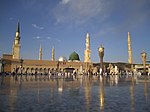Quba Mosque
| Quba Mosque | |
|---|---|
Masjid Qubāʾ (مَسْجِد قُبَاء) | |
Islamic New Classical | |
| Date established | Around 622 C.E. / 1 A.H. |
| Groundbreaking | 622 C.E. / 1 A.H. |
| Completed | 1986 (current) |
| Specifications | |
| Capacity | 30,000+ |
| Dome(s) | 6 |
| Minaret(s) | 4 (current) 1 (original) |
The Quba Mosque (
As per historical Islamic texts, Muhammad spent 14 days in this mosque praying qaṣr (
Architecture
When the Driehaus Prize winner and New Classical architect Abdel-Wahed El-Wakil was commissioned, in the 20th century[vague], to conceive a larger mosque, he intended to incorporate the old structure into his design. But the old mosque was torn down and replaced with a new one.[10]
The new mosque consists of a rectangular prayer hall raised on a second story platform. The prayer hall connects to a cluster containing residential areas, offices, ablution facilities, shops and a library.[citation needed]
The recent new construction of the Quba Mosque that happened in 1984 include many new additions, such as 7 main entrances, 4 parallel minarets, and the 56 mini domes that surround the perimeter of the mosque from an overhead point of view.[9] The courtyard of this mosque is composed of black, red, and white marble,[11] and majority of the structure and interior structures such as the minbar and mihrab are all composed of white marble. Originally, there was one minaret, the new renovations included the addition of the other three minarets, they rest on square bases, have octagonal shafts which take on a circular shape as they reach the top.[citation needed]
Prayer hall
The prayer hall is arranged around a central courtyard, characterised by six large domes resting on clustered columns. A portico, which is two bays in depth, borders the courtyard on the east and west, while a one-bayed portico borders it on the north, and separates it from the women's prayer area.
The women's prayer area, which is surrounded by a screen, is divided into two parts as a passageway connects the northern entrance with the courtyard.[
Landmarks
- Masjid Dirar (previously)
Depending on whether the Mosque of the Companions in the Eritrean city of Massawa[13] is older or not, it may be the first mosque in the world, but according to legend, the sanctuary of the Kaaba in Mecca dates to the time of Ibrahim (Abraham) and Ismaʿil (Ishmael).[14][15]
Mentions
In ahadith
The merits of the mosque are mentioned in nineteen
Muhammad frequented the mosque and prayed there. This is referred to in a number of hadith:
Narrated 'Abdullah bin Dinar: Ibn 'Umar said, "The Prophet used to go to the Mosque of Quba every Saturday (sometimes) walking and (sometimes) riding." 'Abdullah (Ibn 'Umar) used to do the same
— Collected by Muhammad al-Bukhari, Sahih al-Bukhari Volume 2, Book 21, Number 284[17]
Narrated Ibn 'Umar: The Prophet used to go to the Mosque of Quba (sometimes) walking and sometimes riding. Added Nafi Mawla Ibn Umar (in another narration), "He then would offer two Rakat (in the Mosque of Quba)."
— Collected by Muhammad al-Bukhari, Sahih al-Bukhari Volume 2, Book 21, Number 285[18]
In the Quran
It is believed to be the mosque which the Quran mentions as being founded on piety and devoutness (Masjid al-Taqwa)[19]
There are also those ˹hypocrites˺ who set up a mosque ˹only˺ to cause harm, promote disbelief, divide the believers, and as a base for those who had previously fought against Allah and His Messenger. They will definitely swear, "We intended nothing but good," but Allah bears witness that they are surely liars. Do not ˹O Prophet˺ ever pray in it. Certainly, a mosque founded on righteousness from the first day is more worthy of your prayers. In it are men who love to be purified. And Allah loves those who purify themselves.
Gallery
-
The original mosque
-
 Modern Day Quba Mosque in 2013
Modern Day Quba Mosque in 2013
See also
- Holiest sites in Islam
- Islamic architecture
- Islamic art
- Quba in Azerbaijan
- Timeline of Muslim history
References
- ISBN 0-918720-58-3.
- ^ Mustafa Abu Sway. "The Holy Land, Jerusalem and Al-Aqsa Mosque in the Qur'an, Sunnah and other Islamic Literary Source" (PDF). Central Conference of American Rabbis. Archived from the original (PDF) on 2011-07-28.
- ISBN 978-1-62032-136-2.
- S2CID 131955391.
- .
- ^ "Masjid Quba is the first mosque in Islam's history". Masjid Quba'. The Ministry of Hajj, Kingdom of Saudi Arabia. Retrieved 2010-10-19.
- ^ "Ali in the Quran". Balaghah.net. Retrieved 2021-03-02.
- ^ "Quba — the first mosque in the history of Islam". Arab News. 12 July 2014. Retrieved 14 August 2021.
- ^ )
- ^ "Description of the new mosque and architectural documents at archnet.org". Archived from the original on January 8, 2009.
- ^ "Masjid al-Quba – 3D Virtual Tour". www.3dmekanlar.com. Retrieved 2019-12-09.
- ^ Dr. Rasch (6 November 2002), "Alles muss von innen kommen", Gespräch mit dem Stuttgarter Architekten, Islamische Zeitung
- ISBN 978-0-470-65898-7. Retrieved 15 March 2015.
- ISBN 978-0-946621-33-0.
- ISBN 0-0606-3126-0.
- ^ Enter Quba Mosque in the "Search the Hadith" box and check off all hadith collections. Archived October 21, 2014, at the Wayback Machine
- ^ Sahih al-Bukhari, 2:21:284
- ^ Sahih al-Bukhari, 2:21:285
- ^ Tafsir Ibn Kathir 9:108
- Muhammad: The Messenger of Islam by Hajjah Amina Adil (p. 286)
- The Naqshbandi Sufi Tradition Guidebook of Daily Practices and Devotions by Hisham Kabbani (p. 301)
- Happold: The Confidence to Build by Derek Walker and Bill Addis (p. 81)
External links
- Virtues of Masjid Quba, Madina – Taken from Tafsir Ibn Kathir and other Saheeh Hadith








